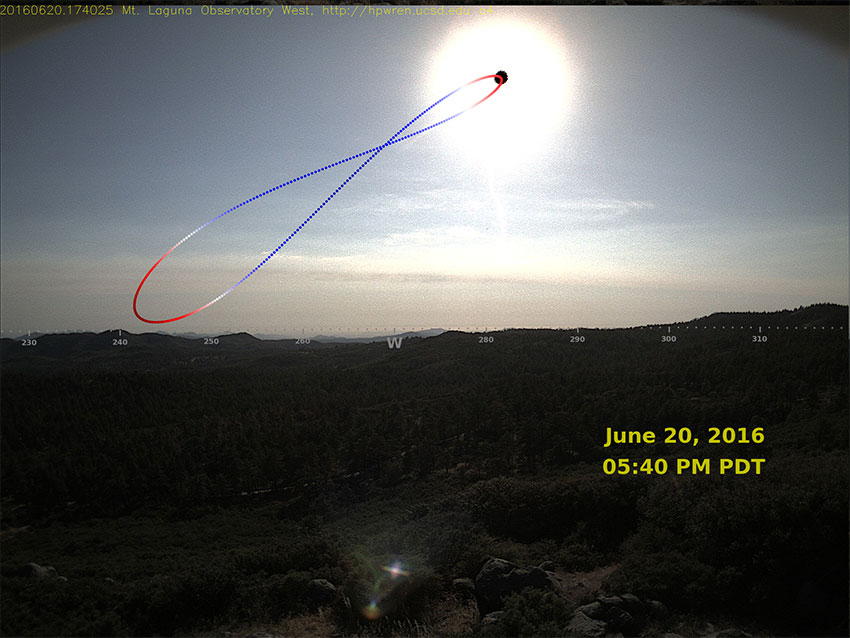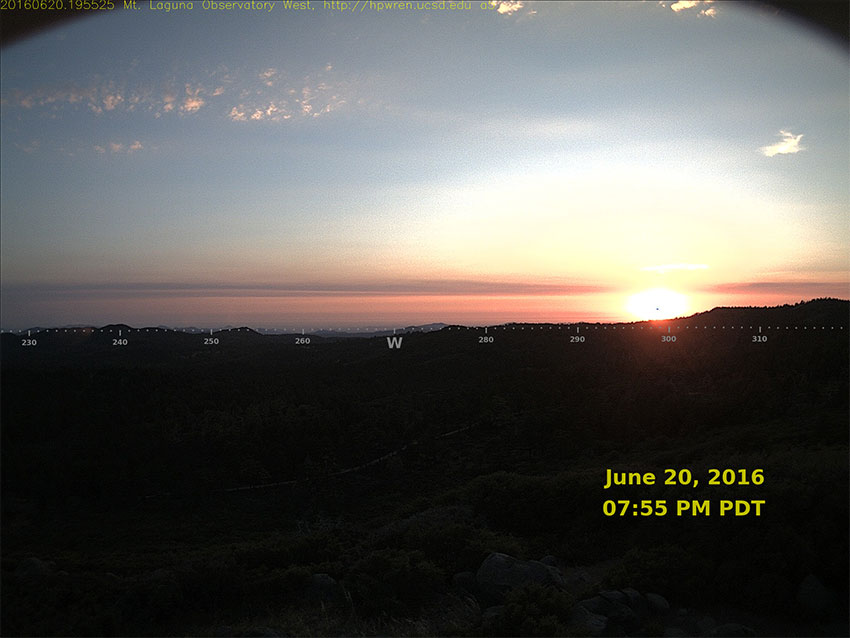Basic Astronomy Demonstrated in HPWREN Time-Lapse Videos
June 6, 2020
By Robert Quimby
Director, Mount Laguna Observatory
Department of Astronomy, San Diego State University
The HPWREN cameras have been recording images minute after minute for the past several years, and this cache of data may be useful for demonstrating basic concepts in astronomy such as the seasonal changes in available sunlight. Time-lapse videos created from these images may help students in introductory astronomy classes better understand the Earth's tilt as it orbits the Sun and the effect this has on our lives.
As an example, I produced a
video ![]() showing the position of the Sun every 24 hours for 3 years
using the West-facing HPWREN camera at the Mount Laguna
Observatory. Some viewers might be surprised by the result. Instead of
returning to the same position every day, the Sun actually traces out
a warped figure 8 known as the "analemma". A simple model with the
Earth spinning and orbiting the Sun in an ellipse can fully explain
the Sun's position on each frame (and predict its position in future
images).
showing the position of the Sun every 24 hours for 3 years
using the West-facing HPWREN camera at the Mount Laguna
Observatory. Some viewers might be surprised by the result. Instead of
returning to the same position every day, the Sun actually traces out
a warped figure 8 known as the "analemma". A simple model with the
Earth spinning and orbiting the Sun in an ellipse can fully explain
the Sun's position on each frame (and predict its position in future
images).

MLO-West camera image of the sun near the 2016 summer solstice. The dots show the path of the Sun in 24 hour steps.
To better quantify this behavior, I have overlaid compass bearings onto the HPWREN images. I did this using some python code in which I first calibrated the altitude and azimuth of each pixel in the sky using a large set of images taken at different times throughout the year and the known altitude and azimuth of celestial objects at the time each image was taken. The dots added to the images trace out the predicted path of the Sun over each year with the color of each dot marking the relative length of the "solar day" (red = longer, blue = shorter) to the "mean solar day" (white dots). The change in the length of the Solar day throughout the year contributes to the analemma's figure 8 shape.
The East-West motion of the Sun from day to day is caused by the tilt
of the Earth's spin relative to its orbit around the Sun. This tilt is
essentially fixed to the stars as the Earth moves through its orbit,
so sometimes the Northern Hemisphere tilts toward the Sun (e.g., in
June), and sometimes it tilts away (e.g., in December). The tilt
toward or away from the Sun is further demonstrated in a second video ![]() , in which I have
selected the HPWREN camera image closest to sunset every day over the
same 3 year period. This video shows that the Sun sets farther to the
North and produces longer days in the summer, and closer to the South
making shorter days in the winter, and this cycle repeats year after
year. I hope these videos will give the viewer a better sense of how
the Earth moves through its orbit and its effect on the seasons.
, in which I have
selected the HPWREN camera image closest to sunset every day over the
same 3 year period. This video shows that the Sun sets farther to the
North and produces longer days in the summer, and closer to the South
making shorter days in the winter, and this cycle repeats year after
year. I hope these videos will give the viewer a better sense of how
the Earth moves through its orbit and its effect on the seasons.
